Your cart is currently empty!
Tag: Centers
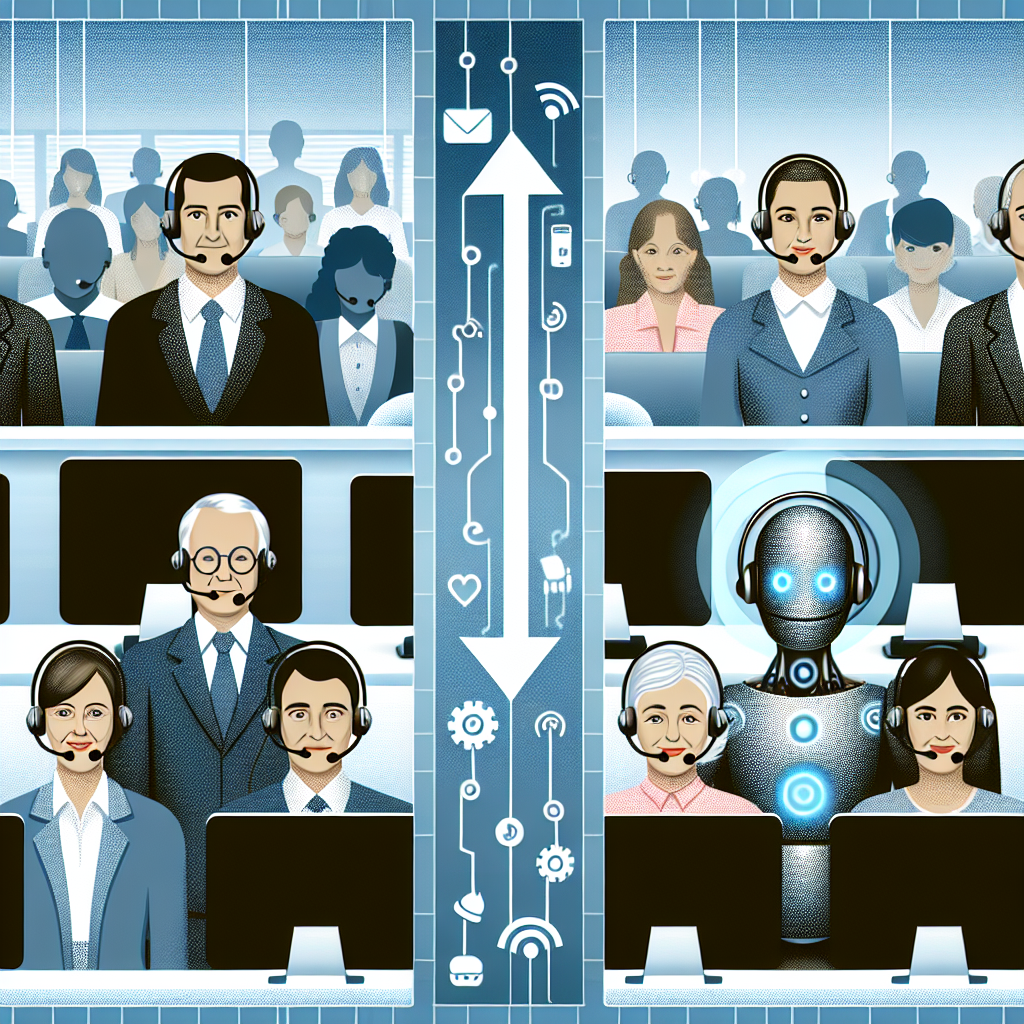
The Evolution of Help Desks: From Call Centers to AI Chatbots
Help desks have come a long way since their inception as call centers, where customers would dial a toll-free number to speak with a representative about their technical issues. With advancements in technology and the rise of artificial intelligence (AI), help desks have evolved into AI chatbots that provide instant support and assistance to customers.The traditional call center model was often plagued with long wait times, frustrating automated menus, and limited availability. Customers would have to navigate through a series of prompts before finally reaching a live representative who may or may not be able to solve their problem. This led to a poor customer experience and decreased satisfaction with the company’s support services.
Enter AI chatbots, the next evolution of help desks. These virtual assistants are powered by machine learning algorithms that can understand natural language and provide personalized responses to customer inquiries. AI chatbots are available 24/7, eliminating the need for customers to wait on hold or navigate through cumbersome menus. They can quickly troubleshoot issues, provide step-by-step instructions, and even escalate complex problems to a human agent if necessary.
AI chatbots have revolutionized the way companies provide customer support. They are efficient, cost-effective, and scalable, allowing businesses to handle a large volume of inquiries simultaneously. By leveraging AI technology, companies can improve response times, reduce customer wait times, and increase overall customer satisfaction.
Furthermore, AI chatbots can collect valuable data on customer interactions, preferences, and pain points. This data can be used to improve products and services, tailor marketing campaigns, and enhance the overall customer experience. By analyzing customer feedback and behavior, companies can identify trends and patterns that can help them better understand their customers and anticipate their needs.
In conclusion, the evolution of help desks from call centers to AI chatbots represents a significant advancement in customer support technology. AI chatbots offer a more efficient, personalized, and scalable solution for businesses looking to provide exceptional customer service. By embracing AI technology, companies can streamline their support processes, improve customer satisfaction, and gain valuable insights into their customer base. The future of help desks is bright, thanks to the power of artificial intelligence.

From Data Centers to the Cloud: The Evolution of Computing Technology
Over the past few decades, computing technology has undergone a significant evolution, moving from traditional data centers to the cloud. This shift has revolutionized the way businesses and individuals store, access, and process data, leading to increased efficiency, flexibility, and scalability.Data centers have long been the backbone of computing infrastructure, housing large servers and storage systems that store and process data. These facilities require a significant amount of physical space, power, and cooling to operate effectively. However, as data volumes continue to grow exponentially, traditional data centers are struggling to keep up with the demand for storage and processing power.
Enter the cloud. Cloud computing technology allows businesses and individuals to access computing resources over the internet, rather than on physical hardware. This means that instead of relying on a single data center, users can tap into a network of servers and storage systems located in various data centers around the world. This distributed infrastructure allows for greater scalability and flexibility, as users can easily scale up or down their computing resources based on their needs.
One of the key benefits of cloud computing is its cost-effectiveness. With traditional data centers, businesses must invest in expensive hardware and infrastructure upfront, regardless of whether they are using all of the resources. In contrast, cloud computing operates on a pay-as-you-go model, allowing users to only pay for the resources they actually use. This can result in significant cost savings for businesses, particularly those with fluctuating computing needs.
Furthermore, the cloud enables greater collaboration and mobility. With data stored in the cloud, employees can access and share information from anywhere in the world, using any device with an internet connection. This flexibility allows for increased productivity and efficiency, as employees can work remotely and collaborate in real-time on projects.
As computing technology continues to evolve, the cloud is set to play an even greater role in shaping the future of IT. Advances in cloud computing, such as the development of edge computing and serverless computing, are further expanding the capabilities and possibilities of this technology. With its ability to provide scalable, cost-effective, and flexible computing resources, the cloud is poised to revolutionize the way businesses and individuals approach data management and processing.
In conclusion, the evolution of computing technology from data centers to the cloud has brought about a paradigm shift in the way we store, access, and process data. With its scalability, flexibility, and cost-effectiveness, the cloud is set to continue transforming the IT landscape and driving innovation in the years to come.
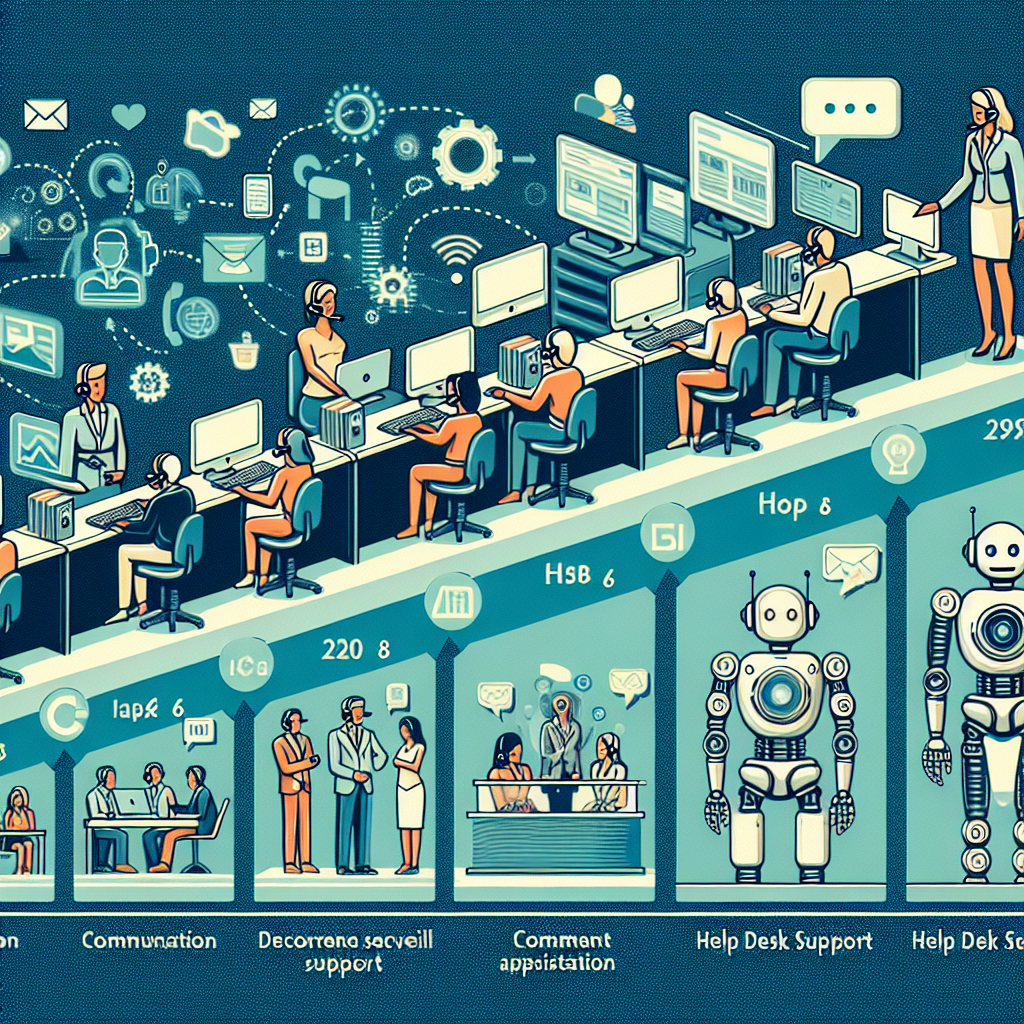
The Evolution of Help Desk: From Call Centers to AI Chatbots
The evolution of help desks has come a long way from traditional call centers to the use of artificial intelligence (AI) chatbots. In the past, customers would have to wait on hold for long periods of time to speak with a representative, only to potentially be transferred multiple times before getting their issue resolved. This process was not only frustrating for customers but also costly and inefficient for businesses.With the advancement of technology, help desk services have transitioned to more efficient and user-friendly solutions. One of the most significant developments in recent years has been the introduction of AI chatbots. These virtual assistants are programmed to understand and respond to customer inquiries in real-time, providing immediate assistance without the need for human intervention.
AI chatbots are able to handle a wide range of customer issues, from simple inquiries to complex problem-solving tasks. They can provide instant responses, 24/7 support, and personalized recommendations based on customer data. This level of efficiency not only improves customer satisfaction but also allows businesses to save time and resources by automating repetitive tasks.
In addition to AI chatbots, help desks have also evolved to incorporate self-service portals and knowledge bases. These online resources allow customers to find answers to common questions and troubleshoot issues on their own without having to contact a support representative. This self-service approach not only empowers customers to solve problems independently but also reduces the workload for help desk staff.
Overall, the evolution of help desks from call centers to AI chatbots has revolutionized the way businesses provide customer support. By leveraging technology to streamline processes and improve efficiency, companies can enhance the customer experience and drive greater satisfaction and loyalty. As technology continues to advance, the future of help desk services will likely see further integration of AI, machine learning, and other innovative solutions to meet the evolving needs of customers in an increasingly digital world.
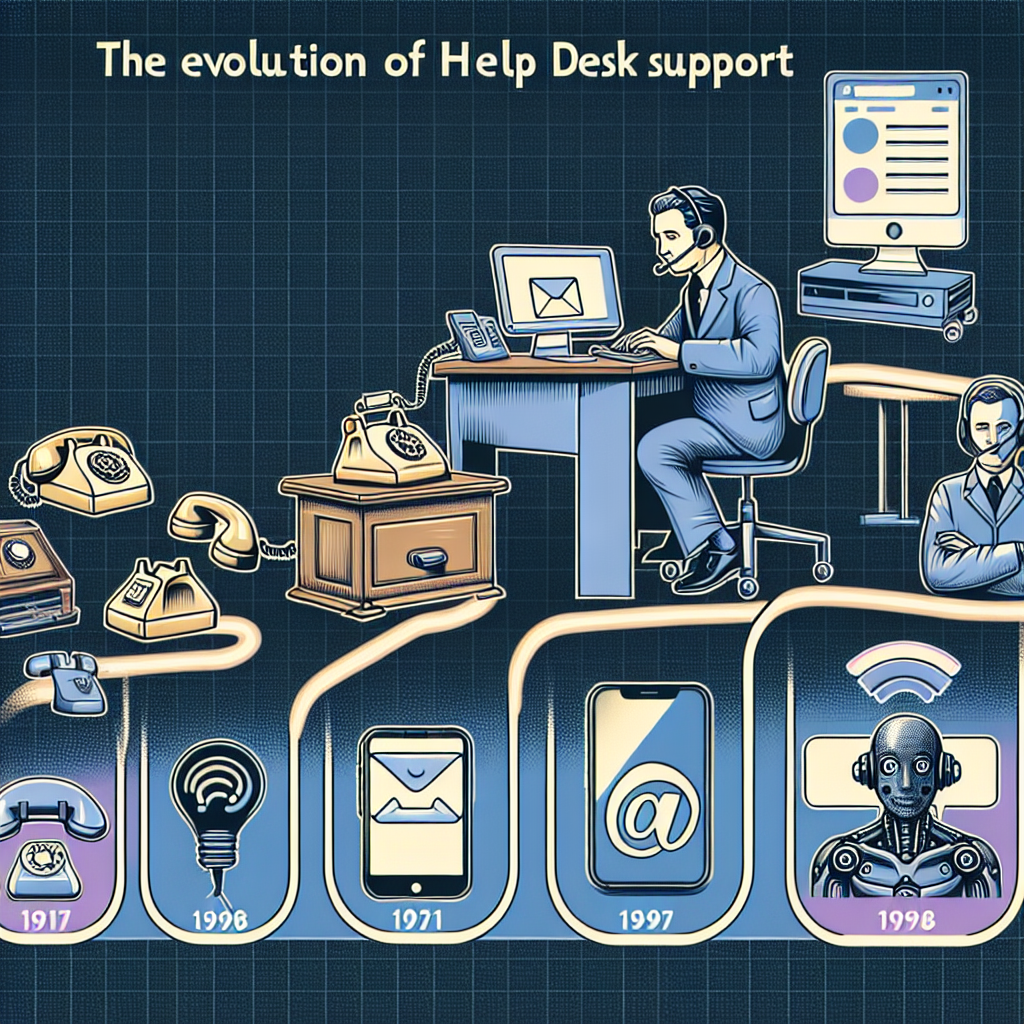
The Evolution of Help Desk Support: From Call Centers to AI Chatbots
In today’s digital age, the way companies provide customer support has evolved drastically. Gone are the days of long wait times on the phone with a call center agent, as more and more companies are turning to AI chatbots to provide instant and efficient help desk support.The evolution of help desk support can be traced back to the traditional call center model. Call centers were once the primary means of providing customer support, with agents fielding calls from customers and attempting to resolve their issues over the phone. While call centers were effective in their time, they often led to long wait times and frustration for customers who were looking for quick solutions to their problems.
As technology advanced, companies began to explore new ways to provide customer support. One of the most significant advancements in recent years has been the introduction of AI chatbots. These intelligent bots are programmed to answer customer queries and provide solutions to common problems in real-time, without the need for human intervention.
AI chatbots have revolutionized the way companies provide help desk support. They are available 24/7, can handle multiple customer inquiries simultaneously, and provide instant responses to customer queries. This has resulted in faster resolution times and increased customer satisfaction.
Another benefit of AI chatbots is their ability to learn and improve over time. By analyzing customer interactions and feedback, chatbots can continuously improve their responses and provide more accurate solutions to customer problems. This results in a more personalized and efficient customer support experience.
While AI chatbots have certainly transformed the help desk support landscape, it’s important to note that they are not a replacement for human agents. There are still instances where human intervention is necessary, especially for complex or sensitive customer inquiries. However, by incorporating AI chatbots into their customer support strategy, companies can provide a more streamlined and efficient support experience for their customers.
In conclusion, the evolution of help desk support from call centers to AI chatbots has significantly improved the way companies interact with their customers. By leveraging the power of AI technology, companies can provide faster, more personalized, and more efficient support to their customers, leading to increased customer satisfaction and loyalty. The future of help desk support is undoubtedly bright, with AI chatbots leading the way towards a more seamless and customer-centric support experience.
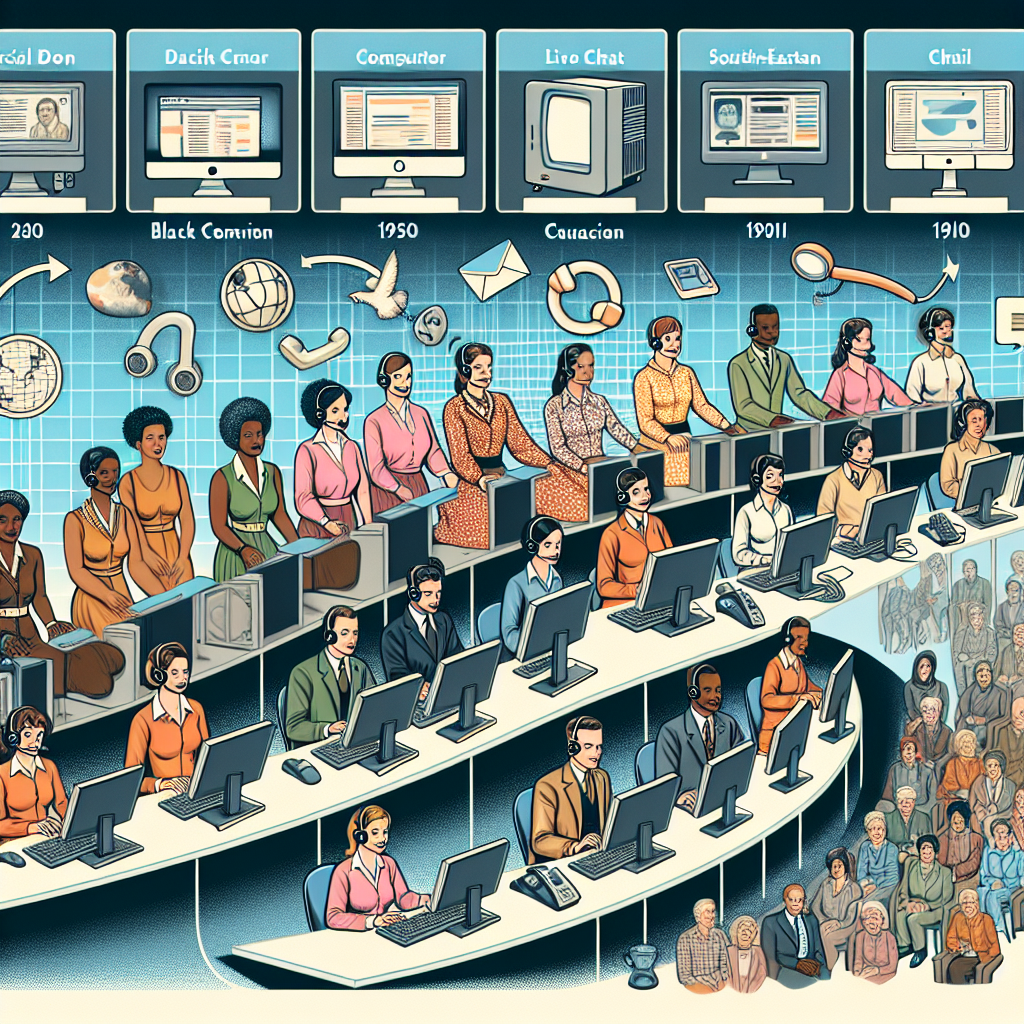
The Evolution of Help Desks: From Call Centers to Omnichannel Support
Help desks have come a long way since their early days as call centers. The evolution of technology and customer expectations has led to the development of omnichannel support, a seamless and integrated approach to customer service that leverages multiple channels for communication.In the past, help desks were primarily focused on providing support over the phone. Customers would call in with their issues and a customer service representative would try to troubleshoot and resolve the problem over the phone. This method was effective for its time, but as technology advanced and customer preferences shifted, businesses began to realize the limitations of a phone-only support system.
As the internet became more prevalent, companies started to offer email support as an alternative to phone calls. This allowed customers to submit their issues in writing and receive a response in a timely manner. Email support was a great addition to help desks, but it also had its drawbacks. Responses could be delayed, leading to frustrated customers and potentially negative reviews.
The rise of social media also changed the game for help desks. Customers began to use platforms like Twitter and Facebook to reach out to companies with their issues. This forced businesses to adapt and create social media teams dedicated to responding to customer inquiries and complaints in real-time. Social media support allowed for more immediate responses and increased transparency, as customers could see public interactions between companies and their customers.
Today, help desks have evolved even further with the introduction of omnichannel support. This approach integrates multiple communication channels, such as phone, email, chat, social media, and self-service portals, to provide a seamless and consistent customer experience. Customers can choose the channel that is most convenient for them, and their interactions are tracked across all channels to ensure a personalized and efficient support experience.
Omnichannel support also allows for better data collection and analysis, enabling businesses to identify trends and patterns in customer issues and preferences. This data can be used to improve products and services, as well as tailor support strategies to meet the needs of customers more effectively.
The evolution of help desks from call centers to omnichannel support reflects the changing landscape of customer service. Businesses are now expected to provide support across a variety of channels, and those that embrace this shift are better positioned to meet the needs of their customers and stay ahead of the competition. As technology continues to advance, it will be interesting to see how help desks evolve further to meet the ever-changing demands of the modern consumer.
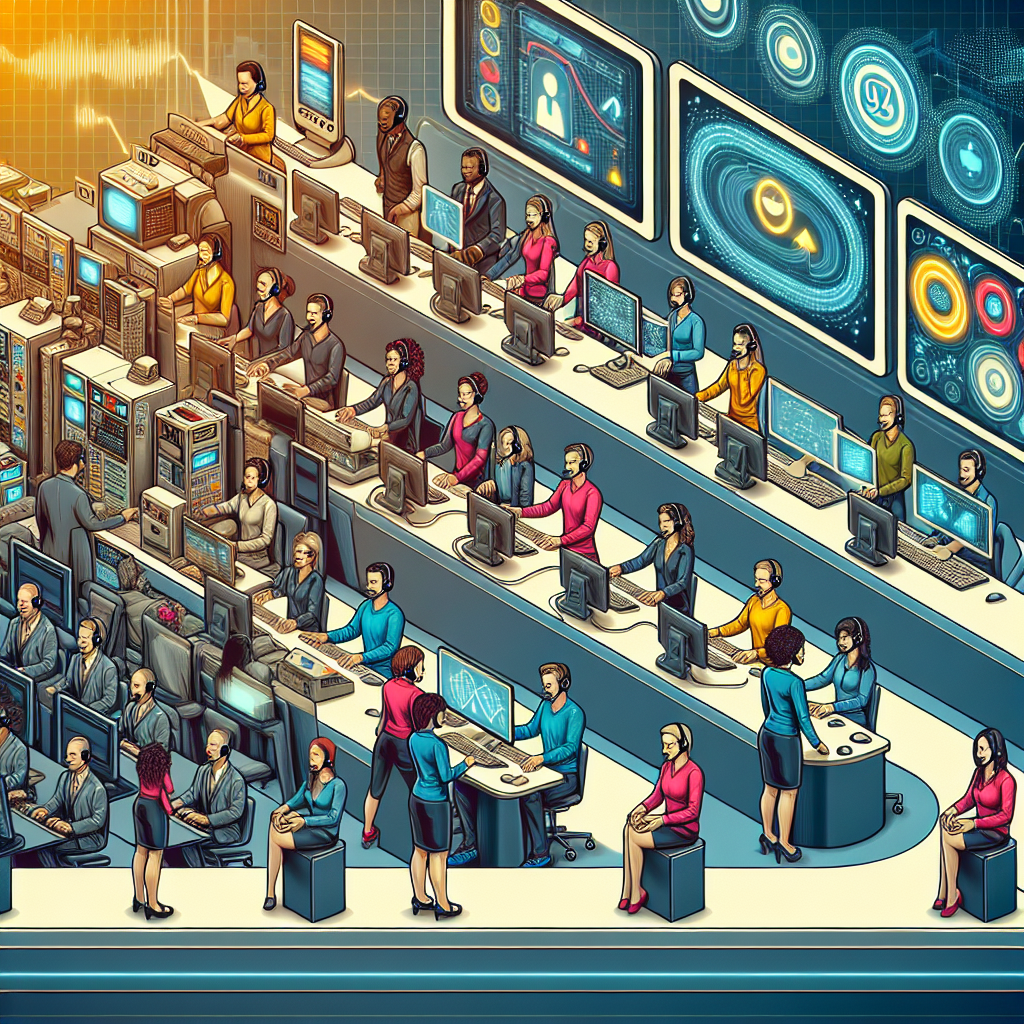
The Evolution of the Help Desk: From Call Centers to Omnichannel Support
The help desk has come a long way since its early days as a simple call center. Today, help desks are able to provide support through a variety of channels, including phone, email, live chat, social media, and self-service portals. This evolution has been driven by a number of factors, including advances in technology, changing customer expectations, and the need for businesses to provide a seamless and consistent support experience across all channels.In the early days of the help desk, customers would typically call a toll-free number to speak with a representative who would help them troubleshoot their issue. While this was an effective way to provide support, it was also time-consuming and often frustrating for customers who had to wait on hold for long periods of time. As technology advanced, businesses began to adopt tools like email and live chat to provide support more quickly and efficiently.
Today, the help desk has evolved into what is known as omnichannel support. This approach allows customers to contact a business through multiple channels and receive consistent and personalized support across all of them. For example, a customer might start a conversation with a help desk representative on live chat, then switch to email to provide more detailed information, and finally follow up with a phone call to ensure their issue has been resolved. This seamless experience helps businesses build stronger relationships with their customers and improve customer satisfaction.
One of the key benefits of omnichannel support is that it allows businesses to meet customers where they are. Some customers prefer to communicate through email, while others prefer to pick up the phone and speak with a representative. By offering support through multiple channels, businesses can cater to the preferences of all their customers and provide a more personalized and efficient support experience.
In addition to improving the customer experience, omnichannel support also helps businesses streamline their support processes and improve efficiency. By centralizing all customer interactions in a single platform, help desk representatives can easily access customer information, track issues, and collaborate with colleagues to resolve complex problems. This not only helps businesses resolve customer issues more quickly, but also allows them to identify trends and patterns that can help them improve their products and services in the future.
Overall, the evolution of the help desk from call centers to omnichannel support has been driven by the need to provide a more seamless and personalized support experience for customers. By embracing new technologies and channels of communication, businesses can build stronger relationships with their customers, improve efficiency, and stay ahead of the competition in today’s fast-paced marketplace.
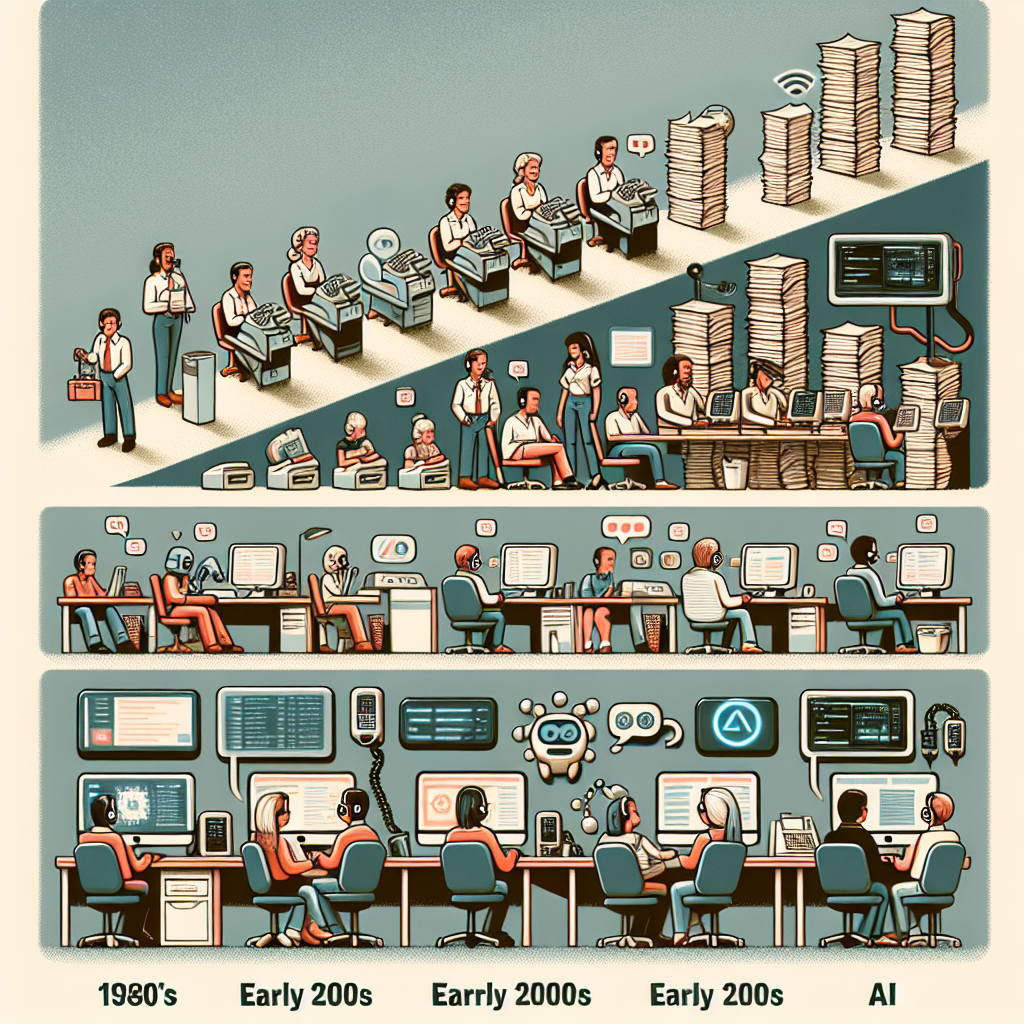
The Evolution of Technical Support: From Call Centers to Chatbots
Technical support has come a long way since the days of call centers and long wait times on the phone. With the advent of artificial intelligence and chatbots, the way we seek help for technical issues has been revolutionized.In the past, when a customer encountered a technical problem with a product or service, they would have to call a support hotline and wait on hold for a representative to assist them. This process was often frustrating and time-consuming, leading to dissatisfaction among customers.
However, with the rise of chatbots, customers now have the option to seek technical support through instant messaging on a website or app. These chatbots are powered by artificial intelligence and can provide quick and efficient solutions to common technical issues. They are available 24/7, eliminating the need for customers to wait on hold or navigate through a complex phone menu.
Chatbots are able to understand natural language and provide personalized responses to customers, making the support experience more seamless and user-friendly. They can also analyze data in real-time to identify trends and improve their responses over time.
In addition to chatbots, companies are also utilizing other technology such as remote desktop support and video conferencing to provide more personalized assistance to customers. These tools allow support agents to troubleshoot technical issues in real-time, without the need for customers to wait for a technician to visit their location.
Overall, the evolution of technical support from call centers to chatbots has greatly improved the customer experience. Customers now have access to instant and efficient support, leading to higher satisfaction and loyalty. As technology continues to advance, we can expect even more innovative solutions to enhance the technical support experience in the future.
Chevron Wants to Tap Into A.I. Boom by Selling Electricity to Data Centers
The artificial intelligence boom has turbocharged demand for electricity, and everyone who is anyone in the U.S. energy industry wants a piece of the action.
The latest entrant is Chevron, the country’s second-largest oil and gas company, which sees opportunity in building natural gas-fueled power plants that will feed energy directly to data centers.
Chevron is working with Engine No. 1, a San Francisco-based investment firm best known for waging a successful proxy battle against Exxon Mobil in 2021. The companies say they have ordered critical equipment, scouted potential sites and can have their first plant online within three years.
“It’s a chance for us to help meet the moment and address this growing need for reliable and affordable power,” Mike Wirth, Chevron’s chief executive, said in an interview.
Chevron’s announcement is the latest example of just how much the promise of A.I. — a voracious electricity consumer — is reshaping the economy. Oil producers are recalibrating their strategies and leaning into power generation, a business that many of them had previously sworn off because it was much less profitable than drilling and processing oil and gas. Just last month, Exxon said that it, too, wanted to get into the business of selling electricity to data centers.
But in a reminder that the prospects for A.I. data centers and growing electricity demand are highly uncertain, technology and energy stocks tumbled on Monday. Investors were unnerved by the stunning advances in A.I. made by an unfamiliar Chinese start-up, DeepSeek, that said it had made its gains using a modest number of computer chips that consumed relatively little energy. Shares of chip-maker Nvidia tumbled 17 percent and the stock of Constellation Energy, a large power producer, closed down more than 20 percent.
“There’s always the potential for markets to surprise you,” Mr. Wirth said. But he added that being early to market and keeping its costs low would protect Chevron against the possibility that power demand growth falls short of current expectations.
His company is hardly alone.
Many power producers are bulking up, and many are investing in natural gas generating capacity specifically. Constellation, which has a large fleet of nuclear power plants, agreed this month to buy rival Calpine, which owns many natural gas plants, for $16.4 billion. And last week, NextEra Energy said it was planning to build more gas-fueled power plants.
Expectations for how much and how quickly U.S. electricity demand will rise vary widely. What’s clear is that data centers are likely to consume a lot more of the country’s power than they do today. A recent study by the Lawrence Berkeley National Laboratory estimated that the facilities are poised to use up to 12 percent of U.S. electricity in 2028, up from 4.4 percent in 2023.
Chevron and Engine No. 1 said they have reserved seven gas turbines from GE Vernova, one of the companies created by the breakup of General Electric. The equipment is set to be delivered beginning in 2026. Chevron and Engine No. 1, which did not say how much they plan to spend, have been in talks with prospective customers and expect to build up to four gigawatts of gas-generating capacity.
Natural gas-fired power plants cost around $2 billion per gigawatt, Morgan Stanley recently estimated.
In this case, the plants would be located alongside the data centers they power. Like Exxon, the partners expect their facilities would not be connected to the electric grid to start, so the plants can get up and running more quickly. It can take years for grid managers to approve connection requests.
Eventually though, they aim to secure grid hookups, said Chris James, Engine No. 1’s chief investment officer. “A grid interconnect allows us to be able to supply power back to the grid when it needs it,” he said.
Technology giants like Microsoft and Google have set targets to get all of their energy from sources that do not contribute to climate change after taking into account carbon capture and other technologies. But some tech companies now say that they will be hard-pressed to get all the power they need in the next few years without relying on natural gas, which produces carbon dioxide when it is burned. The greenhouse gas is the leading cause of climate change.
“It’s this valley between now and then that leaves a lot of people scratching their heads and realizing that if you don’t lean on gas, the answer might be worse,” said Jesse Noffsinger, a partner at the consulting firm McKinsey & Company.
Chevron and Engine No. 1 said their plants could be built in several regions. They have ruled out the East Coast because of infrastructure constraints and feedback from potential customers.
The companies also looked for sites able to accommodate the capturing and sequestering carbon dioxide emissions, said Mr. James.
The companies don’t plan to incorporate that technology or renewable energy at the outset, however.
“We’re very confident that over time as the policy environment clarifies itself, as we make good progress on technology development, that some of these other alternatives will be part of it,” Mr. Wirth said.
Chevron, one of the world’s largest energy companies, is looking to capitalize on the growing demand for artificial intelligence (A.I.) by selling electricity to data centers. With the rapid expansion of A.I. technologies and the increasing need for more computing power, data centers are consuming massive amounts of electricity.Chevron sees this as an opportunity to leverage its expertise in the energy sector and provide a reliable source of power to data centers. The company is exploring ways to optimize its operations and infrastructure to meet the specific needs of data centers, such as providing uninterrupted power supply and implementing energy-efficient solutions.
By tapping into the A.I. boom and catering to the needs of data centers, Chevron aims to diversify its revenue streams and position itself as a key player in the growing digital economy. This strategic move could not only benefit the company financially but also contribute to the development of sustainable energy solutions for the tech industry.
As the demand for data centers continues to rise, Chevron’s initiative to sell electricity to these facilities could prove to be a win-win situation for both parties. Stay tuned to see how this innovative approach unfolds in the coming years.
Tags:
- Chevron A.I. Boom
- Data Centers Electricity
- Chevron Energy Solutions
- A.I. Technology Trends
- Data Center Power Solutions
- Chevron Renewable Energy
- A.I. Innovation Strategy
- Data Center Sustainability
- Chevron Electricity Sales
- A.I. Industry Growth
#Chevron #Tap #A.I #Boom #Selling #Electricity #Data #Centers
Kennedy Center’s Leader to Step Down, Adding to Uncertainty
Deborah F. Rutter will step down as president of the John F. Kennedy Center for the Performing Arts in Washington at the end of the year, the center announced on Monday, in the latest sign of uncertainty at the institution as it navigates President Trump’s second term.
The Kennedy Center had planned to welcome a new board chairman this year, but shortly after the presidential election it announced that it had failed to find a new one and that David M. Rubenstein, who was elected chairman in 2010, would stay on until September 2026.
Ms. Rutter, 68, the center’s president since 2014, guided the organization through the coronavirus pandemic, oversaw an expansion of its campus, added hip-hop and comedy to its offerings and lured the Italian conductor Gianandrea Noseda to be music director of the National Symphony Orchestra. She helped keep the Kennedy Center Honors, the popular annual telecast recognizing distinguished American artists, robust during Mr. Trump’s first term, when he broke with precedent and declined to attend after some honorees criticized him.
Ms. Rutter, whose contract is up in August, agreed to stay on through the end of the year to help with the transition. She said in an interview that the center was looking forward to working with Mr. Trump and his administration, noting that half of the center’s board is made up of his appointees. She said that the first lady, Melania Trump, had already personally expressed interest in reconnecting with the center.
“Republicans don’t love the arts more or less than Democrats,” Ms. Rutter said.
Ms. Rutter said that she was leaving because she was ready for a change, and that it was time for a new generation of leaders to “pick up the mantle and move the Kennedy Center forward.”
“I’m not leaving because I’m tired of the Kennedy Center,” she said. “I’m leaving because it’s time for me to think about using my talents in another way, and for the Kennedy Center to have a fresh new vision.”
The new administration is already having an impact on the arts. Last week, the National Gallery of Art in Washington announced that it would end its diversity, equity and inclusion programs because of Mr. Trump’s executive order calling such initiatives “illegal and immoral.”
The Kennedy Center does not have a formal diversity, equity and inclusion program, according to Ms. Rutter. But the center promotes its commitment to “diversity, equity, inclusion, accessibility and belonging.” And a social credo, drafted in 2021, describes the center’s aim of “elevating and supporting the voices of those who have been historically marginalized and underrepresented.”
Ms. Rutter said the center would review the language it uses to describe diversity efforts in light of the executive order.
The center is still waiting to see the new administration’s arts policies. In his first term, Mr. Trump proposed eliminating the National Endowment for the Arts, but it survived, and even grew, because of bipartisan backing in Congress.
During her tenure, Ms. Rutter, a veteran arts manager who previously led the Chicago Symphony and the Seattle Symphony, oversaw the Kennedy Center’s first expansion in its 54-year history, a complex of studios and classrooms known as the Reach.
The offerings at the center, which runs the Washington National Opera and the National Symphony Orchestra, grew during Ms. Rutter’s time there; genres like comedy and hip-hop are now side by side with classical music, ballet and theater. The center’s budget totaled $268 million last year, compared with $213 million in 2015.
Ms. Rutter was at the helm during the pandemic when the center canceled hundreds of events and lost millions in ticket revenue. She oversaw the start of a major fund-raising drive in 2023 aimed at shoring up the endowment, valued at about $163 million, compared with about $113 million in 2014.
Mr. Rubenstein, who extended his term as board chairman, said he was optimistic about the center’s future, in part because of Ms. Rutter’s strong leadership.
“It will be difficult for us to find somebody who has all of her skills,” said Mr. Rubenstein, a co-founder and co-chairman of the Carlyle Group, a private equity firm. “She’s a difficult act to follow.”
Darren Walker, the president of the Ford Foundation, which has supported the center’s programs, praised Ms. Rutter for expanding the Kennedy Center’s reach.
“The Kennedy Center, as it has become diverse, has become even more effective at fulfilling its mission, which is about excellence,” he said.
Ms. Rutter said she did not know what she would do next, adding that she did not envision leading another large cultural organization. She said her successor would need to find ways to make the Kennedy Center a place that brings Americans together in a time of polarization.
“The arts can and should be a unifying aspect of our society,” she said. “This is our mandate — to what degree can we help people in our country really truly find one another?”
The Kennedy Center, one of the nation’s premier performing arts institutions, is facing a period of uncertainty as its leader, Deborah Rutter, has announced her plans to step down. Rutter, who has served as President of the Kennedy Center since 2014, is credited with overseeing a period of growth and innovation at the organization.Rutter’s departure comes at a challenging time for the Kennedy Center, as the performing arts industry continues to grapple with the impact of the COVID-19 pandemic. The center has faced financial challenges and has had to cancel or postpone numerous performances and events.
Rutter’s successor will face the daunting task of navigating the Kennedy Center through these uncertain times, while also continuing to uphold the organization’s commitment to artistic excellence and community engagement. The search for a new leader is currently underway, but there is no timeline for when a successor will be named.
As the Kennedy Center prepares for this leadership transition, supporters and stakeholders are left wondering what the future holds for this iconic institution. The departure of Rutter adds to the uncertainty surrounding the Kennedy Center’s future, but also presents an opportunity for new leadership to bring fresh ideas and vision to the organization.
Tags:
Kennedy Center, leader, step down, uncertainty, performing arts, arts leadership, arts administration, arts management, cultural institutions, Washington D.C., arts news, arts industry
#Kennedy #Centers #Leader #Step #Adding #UncertaintyJustice Department curtails prosecutions for blocking access to reproductive health centers
WASHINGTON (AP) — President Donald Trump’s new Justice Department leadership issued an order Friday to curtail prosecutions against people accused of blocking access to abortion clinics and reproductive health centers, calling the cases an example of the “weaponization” of law enforcement.
Prosecutions and civil actions under the Freedom of Access to Clinic Entrances Act or “FACE Act” will now be permitted only in “extraordinary circumstances” or in cases presenting ”significant aggravating factors,” attorney general chief of staff Chad Mizelle said in a memo sent to the head of the department’s Civil Rights Division.
Mizelle also ordered the immediate dismissal of three FACE Act cases related to 2021 blockades of clinics in Tennessee, Pennsylvania and Ohio.
Trusted news and daily delights, right in your inbox
See for yourself — The Yodel is the go-to source for daily news, entertainment and feel-good stories.
The memo signals a sharp departure from Justice Department under the Biden administration, which brought cases involving dozens of defendants accused of violating the law. The act prohibits physically obstructing or using the threat of force to intimidate or interfere with a person seeking reproductive health services, and prohibits damaging property at abortion clinics and other centers.
The legal group Thomas More Society, which represents many of the defendants, called the move a “huge moment in the fight against FACE.”
“In each of these three FACE Act cases, Thomas More Society attorneys were representing several brave and peaceful pro-life defendants — who can now breathe easy without the heavy burden of federal prosecutors on their backs,” the group said Friday.
The announcement comes hours after Trump vowed to support tens of thousands of anti-abortion protesters at Friday’s March for Life, declaring, “We will again stand proudly for families and for life” in a prerecorded address. A day earlier, Trump pardoned several anti-abortion activists convicted of blockading abortion clinic entrances in violation of the FACE Act, which is designed to protect abortion clinics from obstruction and threats.
“President Donald Trump campaigned on the promise of ending the weaponization of the federal government and has recently directed all federal departments and agencies to identify and correct the past weaponization of law enforcement,” Mizelle wrote in the memo obtained by The Associated Press.
“To many Americans, prosecutions and civil actions under the Freedom of Access to Clinic Entrances Act (‘FACE Act’) have been the prototypical example of this weaponization. And with good reason,” he wrote.
Mizelle, who was brought on to serve as chief of staff to Trump’s pick for attorney general, Pam Bondi, said “more than 100 crisis pregnancy centers, pro-life organizations, and churches were attacked in the immediate aftermath” of the U.S. Supreme Court ruling that overturned Roe v. Wade. Yet, nearly all of the prosecutions under the FACE Act have been against anti-abortion protesters, he wrote.
“That is not the even-handed administration of justice,” he wrote.
Vice President JD Vance, who spoke to the crowd at the March for Life in person, celebrated pardons for FACE Act defendants and called Trump “the most pro-life American president of our lifetimes.”
Abortion-rights advocates slammed Trump’s pardons of those convicted of violating the law, which was passed in 1994 during a time where clinic protests and blockades were on the rise, as was violence against abortion providers, such as the murder of Dr. David Gunn.
“Not even a week into his presidency, Donald Trump has disregarded the law and greenlit violence against abortion providers, all at the expense of people who wish to live in peace and safely exercise the right to control their own bodies and health,” Krista Noah, national director of affiliate security and response planning at Planned Parenthood Federation of America, said Thursday.
The Justice Department recently announced that it will be significantly limiting prosecutions for individuals who block access to reproductive health centers. This decision comes as a relief to many reproductive health advocates who have long argued that these prosecutions have a chilling effect on free speech and peaceful protest.The Justice Department cited concerns over the potential violation of First Amendment rights as the reason for their decision. They emphasized that while they will still investigate and prosecute cases involving violence or threats of violence, they will no longer pursue cases where individuals are simply peacefully protesting outside of reproductive health centers.
This move has been praised by civil liberties groups and reproductive health advocates who argue that peaceful protest is a fundamental right protected by the Constitution. They argue that limiting prosecutions in these cases will help protect the rights of individuals to express their views on reproductive health issues without fear of legal repercussions.
However, opponents of the decision argue that allowing individuals to block access to reproductive health centers can create a hostile and intimidating environment for patients seeking care. They worry that this decision could embolden anti-abortion activists to engage in more aggressive tactics without fear of legal consequences.
Overall, the Justice Department’s decision to curtail prosecutions for blocking access to reproductive health centers has sparked a heated debate about the balance between free speech and public safety. It remains to be seen how this decision will impact the ongoing battle over reproductive rights in the United States.
Tags:
- Justice Department
- Reproductive health
- Access to healthcare
- Reproductive rights
- Legal news
- Women’s rights
- Abortion access
- Healthcare legislation
- Civil liberties
- Public policy.
#Justice #Department #curtails #prosecutions #blocking #access #reproductive #health #centers
